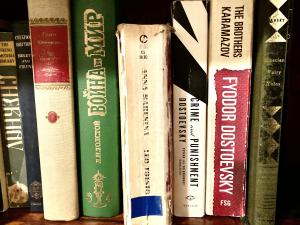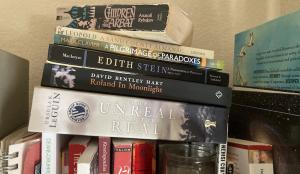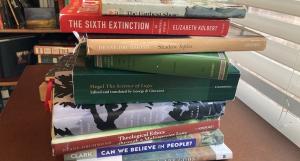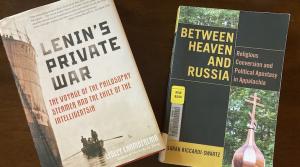“I couldn’t paint a Christ that was not in my soul.”
-Mikhailov, in Tolstoy’s Anna Karenina
Though Lev Tolstoy was no great theologian, he was a bold one. Perhaps at times a bit overbold or self-assured, on my reading. I say that not because of his conclusions, but because he rarely shows interest in the theological ideas of… well, anyone whose name is not Tolstoy. Still: bold. Some of his boldest inquiries come in Anna Karenina.

That may seem like a strange thing to say. The novel is, first of all, a novel, not an allegory or theological treatise. It is secondly, an epic novel, by which I mean that it sweeps through a moment in history as fully as possible, from the lives of peasants to the intrigues of the opera to even the meditations of a dog. Its central concern is with bringing a Russian moment to life. And no one ever has done this better than Tolstoy.
Theology of the Particular
It is also, though, a theological text. This stands to reason. Tolstoy was too interested in questions of God and transcendent meaning to imagine that you could tell an epic story well and leave them out. Here we see him wrestling centrally with the Sermon on the Mount. What is forgiveness? How do we love one another? Can the Golden Rule become an economic system? And of course: what is faithfulness in marriage, and what do we do about divorce?
That’s clearly enough big question-asking for a novel of any (even of this) size. Tolstoy, though, has something else to ask. He wants to know about what it’s like to exist in the world and find faith. How can I live within the smallness of my particular life and believe in the grand meaning of all creation?
For Russians at least, that’s not a question an individual can ask in isolation from a social group. That’s why he begins with that remarkable first line about happy and unhappy families. The two main characters, Anna and Levin, are asking the same faith question from two different directions. Levin asks “how can the love I find at home mean anything if the universe is beyond my understanding?” Anna asks, “how can the universe mean anything if I cannot find love at home?”
The Christ in My Soul
A scene just over halfway through the book shows that Tolstoy understood this to be a christological question.
Anna and her lover and their annoying friend go to see a painter who is working on a large mural of Jesus before Pilate. John and Peter—Jesus’ “family”—are there with him. While the painter waits nervously for them to speak, the three visitors all have different reactions to his work. Anna marvels at the pity Jesus seems to feel for Pilate. Her lover Vronsky admires the skill. “Now there’s technique for you!” The friend challenges the painter’s doctrinal intentions, implying that his image of Christ leaves out the divinity.
“I couldn’t paint a Christ that was not in my soul,” is the painter’s reply.
This response in fact offers a meta-description of the whole scene. The visitors, like the painter, have all “painted a Christ” in their souls. They have told us, I mean, where they place their deepest hope. The friend is a champion of rigid theological correctness. Vronsky is a shallow yet not unlikable admirer of appearances. Anna, though: Anna longs for compassion, forgiveness, and a world that softens enough to love her. Pity is the Christ in Anna’s soul.
Can What’s Human Be Divine?
During this stage, Anna is mostly happy. She lives with a man who loves her, far away from the gossip of the city. Yet we can feel the impossibility of her situation. Her husband will not give her a divorce or let her see her son. There is no real future with Vronsky, and so a happiness only of “technique.” Tolstoy invents a brilliant and subtle symbol of Anna’s narrow happiness: she squints her eyes whenever the difficult thoughts come. It is as if she can only find hope if she looks at a thin slice of her existence. The whole is too horrifying.
I call Anna’s dilemma a christological one not just because of her encounter with the painting. The painter’s response is in some ways the heart of the book. Can a complex life among intimates actually reveal the meaning of everything? Hadn’t I better choose whether to give up on cosmic meaning and enjoy my small life? Tolstoy, I think, is wondering whether the Christ in our soul could be both deeply human and infinitely divine.
“The Kingdom of God is within you,” is the way he put the same dilemma in one of his overt theological texts. The ultimate meaning of God’s creation is a thing you can experience existentially, or it is not. That is the fulcrum of faith.
Experiential Atheism
The Christ in Anna’s soul is pity. Pity is for her a human-divine thing. It is the link between the small love at home and the great love that moves solar systems and galaxies and agricultural economies. And she squints more and more, until finally she cannot believe in pity at all. Anna’s tragedy is not that a cruel society rejects her; it is that she loses faith in love. A world that does not have enough pity for her cannot have pity at all. She loses Christ, the one who carries particular lives into harmony with the universe. Tolstoy, I think, wants us to see that ultimately Anna dies of an experiential atheism. Sorry for the spoiler.
Levin finds his way to faith, finally, by trusting in the happiness inside his home. He can, at least for me, come off a little emo in his well-funded existential angst. But Tolstoy wants us to pull for Levin as we pull for Anya. In them, the book takes us deep into the felt dilemma of two modern humans trying to find their way to a home in God’s creation. Both are trying to evaluate their own lives, loves, and daily routines, and ask, in the words of that annoying friend in the painter’s studio, “is this God or not?”
This one is for my sister, whose handwritten letter about Anna Karenina challenged me to final finish reading it.











